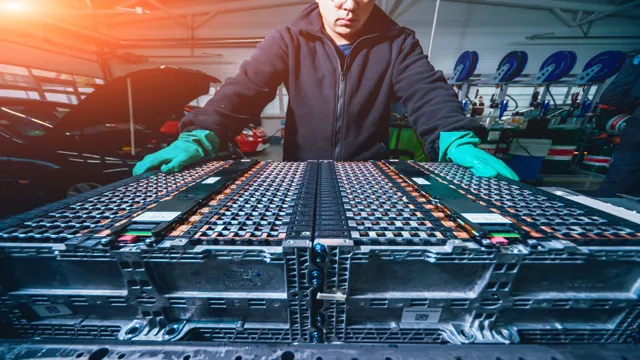Unlocking the Potential: Repurposing Electric Car Batteries for a Sustainable Future
Electric cars have revolutionized the automotive industry, providing a cleaner and more efficient mode of transportation. However, one of the biggest concerns with electric vehicles is the disposal of their batteries. As the battery starts to degrade, it loses its ability to hold a charge, which has a direct impact on the car’s performance.
Some people argue that the disposal of these batteries is not only wasteful but also extremely harmful to the environment. This is where the concept of reusing electric car batteries comes into play. By giving the batteries a second life, we can significantly reduce the amount of waste generated by the automotive industry.
But how exactly does reusing electric car batteries work, and what benefits does it offer? Let’s dive into the details.
Environmental Impact
Many people have concerns about the environmental impact of electric car batteries and wonder if they can be reused. The answer is yes, electric car batteries can be reused, and in fact, there are already many ways they are repurposed. Some companies collect old electric car batteries and use them to store excess electricity from wind or solar farms.
Others use them to power homes during power outages. Furthermore, since electric car batteries can last up to 20 years, there is a great opportunity to repurpose used electric car batteries into new energy storage systems. This process is already taking place in the electric car industry, where old electric car batteries are being used in new car models as a way to reduce waste and lower the costs of manufacturing new batteries.
This means that electric car batteries are not only helping to reduce our overall carbon footprint but are also contributing to a more sustainable future.
Reducing E-waste
Reducing e-waste is essential to lessen the environmental impact of electronic devices. Nowadays, we can’t live without electronic gadgets. Almost everyone owns a smartphone or a laptop, and our dependence on technology is growing rapidly.
However, the production and disposal of electronic devices result in excessive waste that has a detrimental effect on our environment. One of the most significant problems is the release of hazardous materials such as lead, mercury, and cadmium that have toxic effects on human health and the environment. Moreover, e-waste contributes to global warming by releasing greenhouse gases during production and disposal.
To reduce e-waste, we should recycle our old devices instead of throwing them in the trash, and manufacturers should design products that are easily repairable and reusable. By reducing e-waste, we can save valuable resources and protect our planet from environmental degradation.
Lower Carbon Emissions
Lowering carbon emissions is becoming an increasingly important topic nowadays, and with good reason. Our environment has suffered greatly from the constant increase in carbon emissions over the years, leading to issues such as climate change and rising sea levels. In order to try and mitigate the damage already done and prevent further harm, we must first seek to understand the impact our actions have on the environment.
By reducing our carbon footprint, we can make a significant difference in the long-term effects of our actions. This can be done by implementing eco-friendly measures such as using renewable energy sources and reducing our dependence on fossil fuels. By taking small steps towards a cleaner and more sustainable future, we can ensure a healthier planet for generations to come.
Battery Life Span
Many people wonder if electric car batteries can be reused once they reach the end of their lifespan. The answer is yes, they can! While the battery may no longer be suitable for use in a car, it can still have plenty of useful life left in it. Many companies are starting to repurpose these batteries for use in other applications, such as energy storage for homes or businesses.
These “second-life” applications can help reduce waste and provide a cost-effective option for energy storage. Additionally, recycling programs are now in place to help extract valuable materials from used electric car batteries, further reducing waste. So while the lifespan of an electric car battery may be limited, there are plenty of ways to give it a second chance at life.
Number of Charge Cycles
The number of charge cycles is a crucial factor in determining the battery life span of your device. Charge cycles refer to the number of times a battery can be charged and discharged. Every time you charge your battery, it loses a small amount of its capacity.
Over time, these losses add up and affect the overall performance and lifespan of your battery. Lithium-ion batteries, which are commonly used in modern devices, can usually last for around 300-500 charge cycles before they start to degrade. However, it’s important to note that factors such as temperature, usage habits, and charging habits can also affect the number of charge cycles your battery can handle.
To extend the life of your battery, try to minimize its exposure to extreme temperatures, avoid deep discharges, and charge it before it reaches zero. By taking these steps, you can ensure that your battery lasts longer and delivers reliable performance for years to come.
Factors Affecting Life Span
When it comes to battery life span, there are several factors that can affect it. One of the most significant factors is the battery’s charging and discharging cycles. Every time the battery goes through a full charge cycle, it gradually loses some of its capacity to hold a charge.
The type and frequency of usage also play a significant role in battery life span. For example, if you use your device heavily, such as playing graphics-intensive games or running demanding applications, the battery will drain faster. Another factor that can affect battery life span is temperature.
Extreme heat or cold can significantly reduce the battery’s capacity, leading to shorter battery life. So, to extend your battery’s life span, it is essential to take care of it by avoiding extreme temperatures, avoiding overcharging, and optimizing your usage patterns.
Battery Repurposing Applications
Battery repurposing applications are becoming increasingly popular due to a growing concern for environmental sustainability and a desire to save money. One of the major factors affecting battery repurposing is the battery life span. Batteries are designed to have a limited lifespan, after which they will start deteriorating and not function as well as before.
The lifespan of a battery depends on the type of battery, manufacturer, and usage. Some batteries can last for years, while others may only last for a few months. When a battery reaches the end of its lifespan, it can no longer be used for its original purpose.
However, it can be repurposed for other applications, such as powering smaller devices or being used as a backup power source. Repurposing batteries not only reduces waste but also saves resources and money. So, instead of throwing away your old batteries, consider repurposing them for a different use and contribute to the sustainability of our planet.
Technical Feasibility
As the world focuses on reducing carbon emissions, the demand for electric vehicles is increasing. This raises the question, can electric car batteries be reused? The answer is yes, they can. While the battery may no longer be suitable for powering a vehicle, it can still have a second life in other applications such as home energy storage or powering electric bikes.
Technology is developing rapidly, and some batteries may even be able to be refurbished and installed in other electric vehicles. However, there are still technical challenges that need to be addressed, such as standardization and the development of efficient recycling methods to prevent environmental harm. Nonetheless, the potential for reusing electric car batteries provides a glimpse into a future of sustainable energy practices, reducing waste, and fostering the circular economy.
State of Charge
When it comes to electric vehicles, State of Charge (SoC) is an important technical aspect to consider. SoC is essentially the amount of charge remaining in the vehicle’s battery. This information is crucial because it determines how far the vehicle can travel before needing another charge.
The technical feasibility of SoC involves implementing accurate sensors and systems that can measure and display the remaining battery charge to the driver. It also involves creating algorithms that calculate the range based on SoC, enabling drivers to plan their trips accordingly. The development of more advanced battery technology can also improve the accuracy and efficiency of SoC.
Overall, a reliable SoC system is necessary for electric vehicles to become a more mainstream and viable option for transportation.
Battery Management System
A battery management system (BMS) is a vital component in any battery-powered device, whether it be a handheld device or an electric vehicle. One major advantage of a BMS is its ability to prevent overcharging or over-discharging of the battery, which can cause irreversible damage. This system monitors the state of the battery and controls the charging and discharging process to maximize the battery’s lifespan.
Additionally, a BMS can provide information about the battery’s health, such as its current capacity, voltage, and temperature. Since the power output and performance of a battery depend on its state of charge, a BMS ensures that the battery is always delivering optimal power. Overall, a battery management system plays a critical role in enhancing the efficiency and safety of any battery-powered device.
Conclusion
In conclusion, the question of whether electric car batteries can be reused is not a simple yes or no answer. While technically they can be reused, it depends on a variety of factors such as the condition of the battery, the cost of reusing it, and the demand for recycled batteries. However, as technology continues to advance, we may find more innovative ways to reuse and repurpose electric car batteries beyond their original intended use.
So let’s charge forward towards a more sustainable future with electrifying possibilities!”
FAQs
What is the average lifespan of an electric car battery?
The average lifespan of an electric car battery is around 8 to 10 years, but it can vary depending on factors such as usage and maintenance.
Can electric car batteries be recycled?
Yes, electric car batteries can be recycled. The materials used in the batteries, such as lithium and cobalt, can be reprocessed and used in the production of new batteries or other products.
Is it possible to reuse old electric car batteries?
While it is possible to reuse old electric car batteries, they may not provide the same level of performance as a new battery. Some companies are exploring the use of repurposed electric car batteries for energy storage systems.
How much does it cost to replace an electric car battery?
The cost of replacing an electric car battery can vary depending on the make and model of the vehicle. In general, it can range from a few thousand dollars to tens of thousands of dollars. However, many electric car manufacturers offer warranties and other programs that can help offset these costs.





